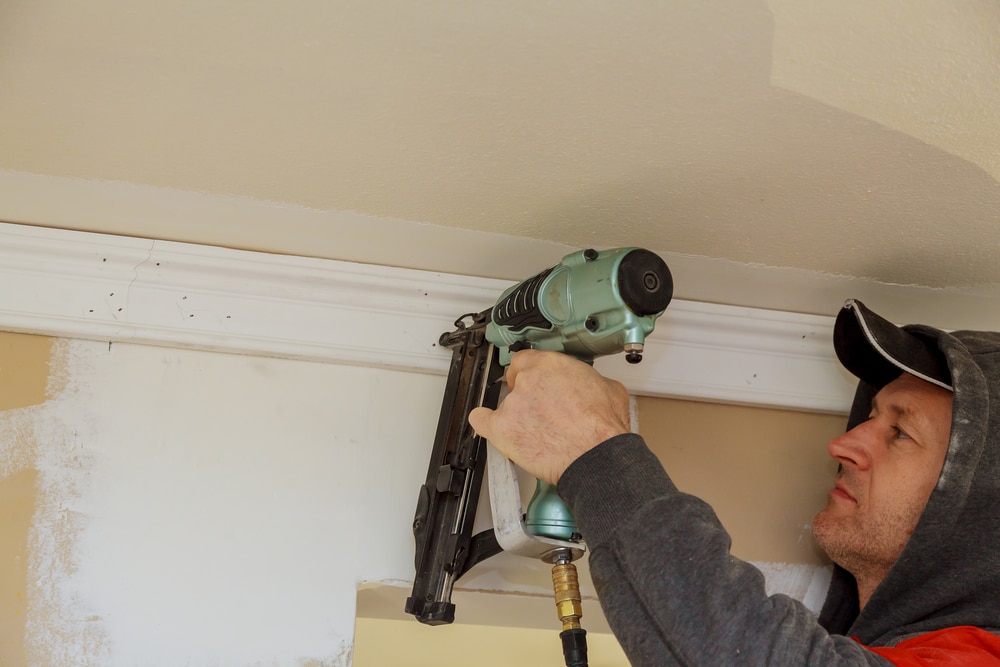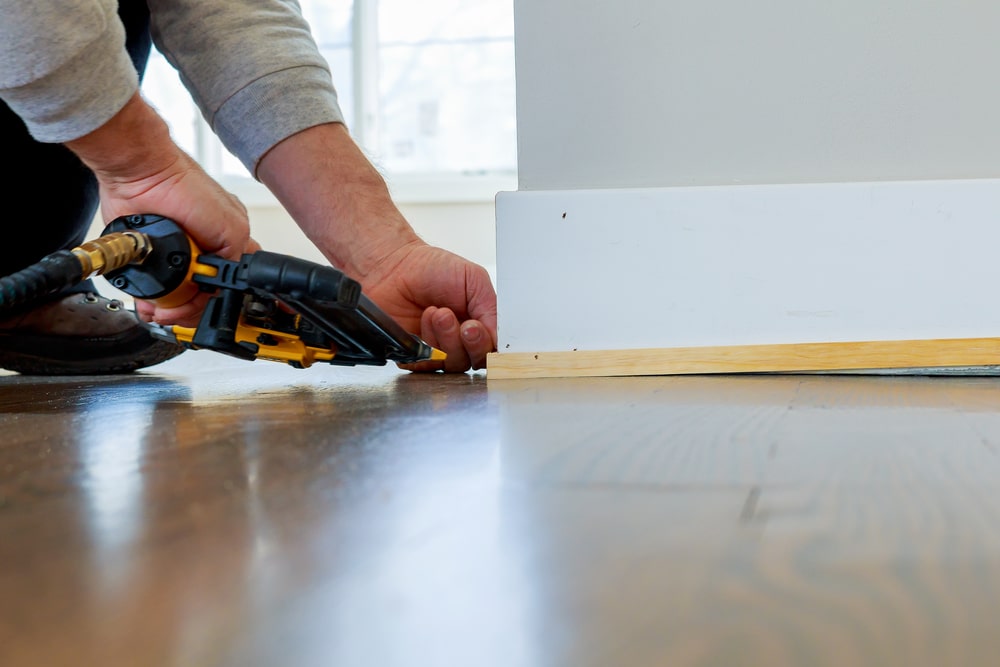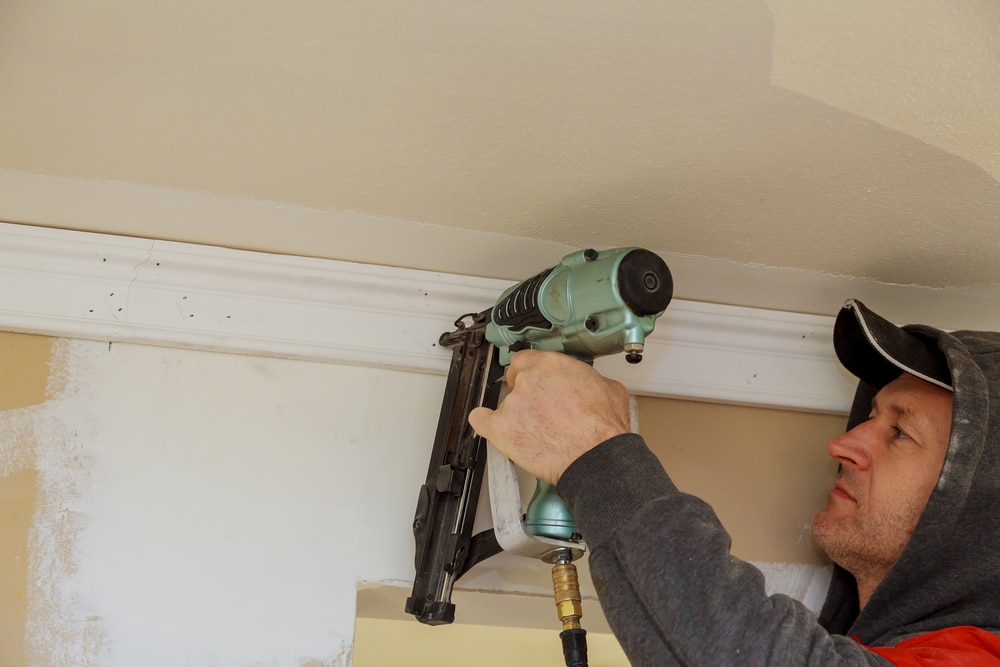Are you about to take on a crown molding project in your home? If so, you might be wondering what the best nailer to use is.
In this article we’ll find out, delving into the different types of crown molding nailers you could use and how to determine which is the best one for the job!
Crown molding is a great way to add extra value to a room, injecting style and design.
Crown molding also elegantly hides imperfections and cracks on walls and ceilings, and can be designed to fit in with any space. If you’re planning on installing crown molding in your home, keep reading to find out what nailer you’ll need to do the job!
In this guide, we’ll cover:
- Understanding crown molding nailers
- Types of nailers for crown molding
- Choosing the right nail size
- Tips for selecting the best nailer.
Table of Contents
Understanding Crown Molding Nailers

Before we delve into examining the different varieties of nailers available, let’s take a look at what exactly crown molding is and why nailers are so important in the installation of crown molding.
Crown molding is typically used in homes and other spaces for decorative purposes.
They are commonly used in the area between the ceiling and walls; however, crown molding is also frequently used on windows, cabinets, bookshelves, and doors.
A large variety of different designs can be used for crown molding, ensuring that the molding fits into the existing design of any home.
In addition, a variety of materials may be used for crown molding including wood, plaster, rubber, and polyurethane.
All in all, crown molding is an ideal way to add style, value, and design to your home or space!
So, where do crown molding nailers come into it?
Crown molding is attached to the desired space through the use of nailers, which firmly secure the crown molding planks down.
Therefore, you need to ensure that the nailer you choose is right for the job to ensure proper installation without damage or malfunction.
Types of Nailers for Crown Molding

Now that we’re clear on the purpose of crown molding and why the nailer you use is so important, let’s examine the different types of nailers available and their respective benefits and limitations:
Pneumatic Nailers
Pneumatic nailers use compressed air to drive the nails out of the nail gun.
One of the benefits of using pneumatic nailers is that they tend to be very lightweight and easy to handle.
As a result, they are also very versatile and used for a range of tasks!
As a nailer for crown molding, this makes them great for hard-to-reach places such as tight corners. In addition, they are well equipped to deal with fast work and are highly reliable.
Cordless Nailers
Cordless nailers work through a rechargeable battery and use fuel cartridges to drive the nails.
Cordless nailers are great due to their ability for easy handling which creates versatility and ease of use.
However, fuel-powered nailers aren’t as fast-firing as pneumatic nailers – making it slower to get the job done. Furthermore, replacing fuel cartridges can be expensive.
Brad Nailers vs. Finish Nailers
Brad nailers and finish nailers are fairly similar, but they do have important differences. Finish nailers are significantly larger than brad nailers with larger nails.
As a result, finish nails will produce a stronger hold, but brad nails are more suitable for finer work that requires smaller nails.
Overall, finish nailers will hold your crown molding better than brad nailers. However, Brad nailers may be more suitable for more delicate molding on smaller projects. Both Brad nailers and finish nailers also come in cordless and pneumatic varieties.
Choosing the Right Nail Size
Another consideration alongside the type of nailer you use is the size of the nail.
The best size nailer for you depends on the type of crown molding you are installing.
For larger crown molding, use nail sizes of approximately 15 to 16-gauge 2-inch nails to ensure that the crown molding will hold.
For more delicate crown molding, use approximately 18 gauge 1-inch nails that won’t split the material of the crown molding.
The nail should be long enough that it firmly secures the molding to the wall! Generally, the nail should be twice as long as the thickness of the crown molding and the drywall behind it to ensure it will hold.
You will also need to consider the gauge of the nail. If you are installing more delicate crown molding, using a smaller gauge nail will ensure a cleaner finish and prevent the risk of splitting the molding when driving the nail.
Tips for Selecting the Best Nailer

To help you select the best nailer for your crown molding installation, here are some tips you should keep in mind in the process:
Consider Your Project Scope
When selecting the best nailer, you’ll want to consider the scope of your project. If you are installing a small amount of delicate molding, this will require a nailer suited for finer detail such as a Brad nailer.
In contrast, if you are installing large molding in a large room, your main priority will be to ensure that the nailer is large enough to hold the molding in place, such as a finish nailer.
Budget and Features
In choosing your preferred gun, consider the scope of your budget. Brad nailers are less expensive than finish nailers; therefore, if you only have a small job to do, this may be your best bet!
When considering the cost of cordless vs pneumatic nailers too, the pneumatic version comes out on top.
You’ll also need to consider what you want the nailer to be able to do performance-wise or any specific features you would like it to have.
For example, do you need a long-performing nailer, one that is lightweight, or one that is easily maneuverable?
Are you willing to replace fuel cartridges, or are you after a nailer that requires less attention?
Ergonomics and User-Friendliness
It’s also important to consider the ease of use of the nailer. Brad nailers are more lightweight; however, finish nailers are better equipped to reach into hard-to-access places.
In addition, finish nailers have a higher nail capacity and need to be loaded with new nails less frequently. If installing molding in tight corners, a finish nailer is your best bet!
Furthermore, if you’re doing a large job and don’t want to keep reloading your nails, then finish nailers are the superior nail gun.
Brand Reputation and Warranty
When choosing your nailer you’ll also be wise to consider the brand of the gun and the corresponding warranty coverage.
Some of the best brands with a strong reputation for nail guns include DeWalt, Porter-Cable, Milwaukee, and Bostitch.
You should also ensure the nail gun you purchase has a solid warranty of at least two years in the case of malfunction or breakage. There’s no point investing in an expensive nail gun if it isn’t guaranteed to last!
Final Words
As we’ve seen, there are a number of different factors involved when choosing the best nailer to use for crown molding.
First and foremost, you need to consider the type of crown molding you are installing.
Are you working on delicate cabinetry or window crown molding? In that case, a Brad nailer is without doubt the tool you should be using. Or, are you installing large molding in a large room?
In this case, you need to use a finish nailer with large enough nails to ensure the wood is able to hold securely in place.
Lastly, it’s worthwhile considering extra considerations for specific projects, such as the need to reach tight corners, as well as any personal preferences like having a lightweight tool.
Ultimately, when selecting the nailer you use to install crown molding, this requires careful consideration of the project at hand and what you are looking for and expecting in a nail gun!
